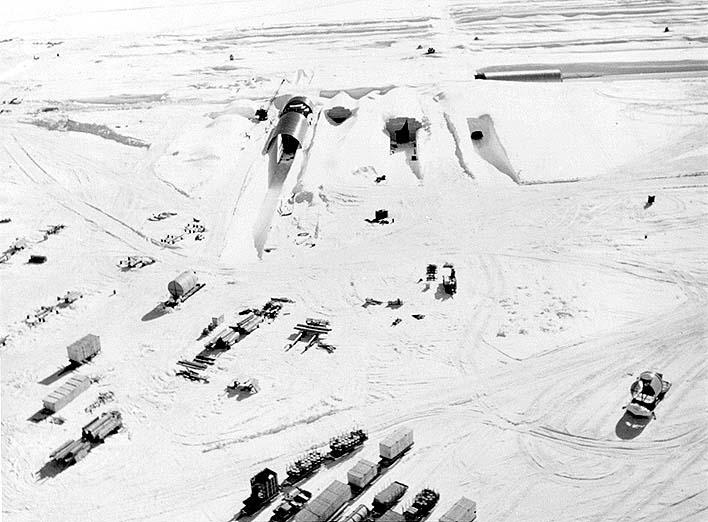Unearthing the Arctic's Toxic Past: Camp Century and Cold War Secrets

As temperatures warm and ice melts, climate change is giving new life to a new politically contentious hazard - biological, chemical, and radioactive waste in Greenland’s forgotten Cold War NATO basecamp.
While the ‘new Cold War’ between Russia and the West may be the dominant narrative for Arctic security debates today, the legacy of the 20th Century Cold War is cause for a different, if not more frightening, type of scare: leaking toxic waste.
A new study published in the Geophysical Research Letters journal has shown that the ice melt from a changing climate guarantees the eventual remobilization of physical, chemical, biological, and radiological waste abandoned at Camp Century in Greenland nearly 40 years ago. The research was completed by an international group of scientists from Canada, Denmark, Switzerland, and the United States, who used climate projections based on both historic simulations and recent trends to map the expected leaking of waste from the base site.
The study’s findings are stark: once thought of as ‘eternally preserved,’ the site’s abandoned waste is expected to leak into the Arctic within the next 75 years.
A Third World War, A Ice Base
The technological advancements of aero-engineering in first half of the 20th Century reshaped the world map. No longer did physical geographical obstacles like water and mountains cut off nations from one another. With the advent of military planes and intercontinental ballistic missiles every individual now lived on the edge of an accessible and exposed ocean – the air ocean.
This was most true at the top of the world. Where once leaders saw an impassable, endless frontier, Western governments now saw a direct air route from Moscow to Washington. Summed up by General H.H. Arnold in 1946, a retired chief of the Army Air Forces, “If there is a third world war, its strategic center will be the North Pole.”
The construction of Camp Century in Greenland was born from this fear at the height of the Cold War in 1959. Eight years before the Camp was built, Denmark and the United States signed the Defense of Greenland Agreement, establishing three air bases and, after extensive research of the ice sheet, a base eight meters below the ice sheet’s surface. Built by the US Army Corps of Engineers, Camp Century provided year-round accommodation for anywhere between 85 and 200 soldiers, powered by a portable nuclear generator.
The ultimate goal of the Camp was to support a mission to deploy nuclear ballistic missiles within the ice sheet through a railway system known as Project Iceworm. However, ice core sampling between 1960 and 1963, which ironically provides much foundational science for climate change research today, demonstrated that the glacier was moving too fast to invest in building sub-ice launch stations.
Project Iceworm was abandoned in 1964 and after three years of seasonal operation Camp Century was abandoned in 1967 – its waste and infrastructure assumed to be preserved for eternity by perpetually accumulating snowfall and ice.
The last time the site was monitored was in 1969, when all seemed well and frozen. But climate change is making old problems new again.
Lots of Waste
Because there was little surface melting in Greenland in the 1960s, the Camp’s built infrastructure was left inside the collapsing tunnel system with little decommissioning. But the physical waste of buildings and railways is only one form of waste left at Camp Century four decades ago. Biological waste like grey water and sewage; chemical waste like diesel fuel and polychlorinated biphenyls (PCBs); and radiological waste from the now removed nuclear generator can all still be found underneath the surface of Greenland’s ice sheet.
As climate change expands the ablation zone in Greenland – areas where annual meltwater exceeds annual snowfall – the liquid waste is beginning to leak. There has been a recorded increase in meltwater since 1990,but recently, particularly between 2007 and 2011, the ice drainage system around Camp Century has an unprecedented amount of water runoff.
The consequences of this cannot be understated. Remobilized persistent organic pollutants like PCBs, for example, can cause major ecosystem and human health problems, including cancers, development abnormalities, and brain and nervous system impairment.
And while the site may not be exposed for another 75 years by surface runoff, the increased englacial water flows inside the glacier itself could remobilize PCBs decades sooner.
A New Political Dispute
With the threat of leaking toxic waste endangering community and ecosystem health in the near future comes a question of responsibility for its cleanup.
In the 1951 Treaty that allowed Camp Century to be build, “All property provided by the Government of the United States of America and located in Greenland shall remain the property of the Government of the United States of America… [it] may be removed from Greenland free of any restriction, or disposed of in Greenland by the Government of the United States of America after consultation with the Danish authorities…”
The Treaty’s ambiguous clause on ownership is only further complicated by the secrecy of Project Iceworm. While the Danish Government was aware of the construction of Camp Century, it is unclear whether Denmark was sufficiently consulted regarding the full extent of its operations and subsequent abandoned waste. And with the multinational nature of Camp Century, the new study highlights the legal uncertainty associated with mitigating the remobilization of its pollutants.
As Denmark, Canada, and the United States shift focus from the ‘new Cold War’ to the legacies of the old, a different type of climate conflict may arise – not one of shipping lanes or seabed rights, but of accountability to clean up the Arctic’s toxic past.
